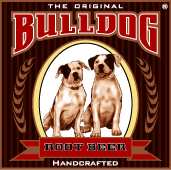|
Very Early Root
Beer
Way back in ancient
times, and up until hops were discovered in about 1400 AD, people had
to rely on roots and bark and other spices to provide the bitterness
and preservative qualities in small beer. However, small beer did not
become root beer until the Europeans settled America. Did you know the
Mayflower landed at Plymouth Rock, Massachusetts, instead of Virginia
because they ran out of beer? Before departing England, some water was
brought on the ship for the long voyage, but water spoils in wood kegs
after a short time, therefore beer was the main liquid that the people
aboard the Mayflower drank to stay alive. Drinking seawater would have
killed them.
Once the colonists
settled all over the east coast, they built towns, and they built breweries
too. However they were truly pioneers even in the towns, and they did
most things for themselves, and that included baking bread and brewing
beer at home. Unfortunately they didn't have crops of barley or other
grains to use when making their small beer, so they had to use other
sweeteners such as honey, molasses, and cane sugar. And they didn't
have hops for bitterness, so they had to discover which plants in the
new world would provide bitterness and flavor. That is the real beginning
of root beer! It is truly as American as apple pie, and a lot older
than apple pie. Some of the plant materials that have been used in root
beer over the years include sarsaparilla root, sassafras root, dandelion
root, ginger root, yellow dock root, burdock root, spikenard root, birch
bark, wild cherry bark, wintergreen bark, prickly ash bark, spicewood,
allspice, juniper berries, vanilla bean, coriander seed, licorice, dog
grass, pipsissewa, cardamom, cinnamon, and even hops. Some recipes did
not use roots, or relied mainly on one ingredient, and that's where
Birch Beer and Sarsaparilla Soda came from. However, root beer was the
king in popularity even back then.
Home-Brewed Root
Beer
This truly old-fashioned
root beer would have tasted different from the kind you buy at the store
today. It would have been a bit cloudy, and it would have tasted less
sweet, and therefore a little dry. When I was a girl, my family made
root beer once for fun, and I think it was a lot like those early root
beers. My dad bought a bottle of Hires Root Beer Extract, and following
the directions on the little bottle, we added it to a big pot of water,
then added sugar and a teensy amount of yeast. We stirred it up, bottled
it, and then capped the bottles. We made about two cases or 5 gallons,
and yes, some of the bottles exploded. The yeast was needed to carbonate
the root beer, and some of the bottles developed an excessive amount
of carbonation and foamed all over when we opened them. The alcohol
level was tiny, probably about half-a-percent. We kids didn't like it
so much, because we were used to super sweet sodas from the store, so
we poured it over vanilla ice cream to make floats and the ice cream
sweetened it up enough for us. Many people make their own home-brewed
root beer from concentrates today, and there are plenty of recipes on
the Internet for people who want to try to make an authentic old time
root beer from roots. However, it is hard to find all the roots, barks,
and spices needed to make root beer, which is why people buy concentrate.
Bubbly Beverages
The next step in
the evolution of Americas' most indigenous modern drink, root beer,
was that somebody had to figure out a way to carbonate it without fermenting
it with yeast. The history in that branch of the root beer family tree
leads us back along a different route, to the belief that soaking in
naturally bubbly mineral springs could help to heal or cure illnesses.
The word bath comes from a place in England called Bath, which had just
such a type of spring. Once I was in western Turkey on vacation, and
"took the cure" in the springs at Pamukkale. The water was
warm, I felt buoyant, and bubbles formed on my skin. It was like swimming
in a big pool of warm seltzer water!
In olden times this
kind of water was considered very healthful, and even if you couldn't
sit and soak in it, perhaps you could drink it. A market for bottled
bubbly spring water developed, and people who couldn't travel to "take
the cure" bought the bottled water to drink. It was a very rare
kind of water, and of course very expensive. Then in 1767 Dr. Joseph
Priestley in England invented a way to create carbonated water artificially.
This artificially produced mineral water was also considered healthful,
and as new inventors fine-tuned the production process, bottled carbonated
water gained wider distribution and popularity. It didn't take long
for people to begin to flavor the bottled bubbly water, similar to our
flavored carbonated waters of today. This was the birth of the soda
industry, as we know it.
The Hires Formula
For Success
Now a third branch
in the root beer family tree involves a man named Charles Hires, a pharmacist
and brilliant entrepreneur living in Philadelphia. Many people say that
Charles Hires invented root beer, but as you can see, the colonists
had been making root beer for 200 years before Charles Hires was born.
In fact, there were some commercial root beer brewers such as Caleb
Smith, in Flushing, New York, as far back as the 1850's, who produced
a fermented draft root beer.
However, Mr. Hires
was the first to commercially produce root beer in bottles, and he was
a great promoter as well. The legend says that on his honeymoon, visiting
his home state of New Jersey, Charles and his bride stayed at a guest
farm where the landlady served them her homemade herb tea. Charles either
got the recipe from her, or secured a packet of the herb tea mix, and
then went back to Philadelphia to figure out the recipe. Once he put
together a recipe to his satisfaction, he began to sell the herb-mix
packets at his pharmacy. Being the astute businessman that he was, he
sold boxes of the packets to other pharmacies to sell as "Hires'
Herb Tea", and he also sold it at the 1876 Philadelphia Centennial
Exposition. The directions said to boil the ingredients, strain them,
and add sugar to the liquid, then add yeast and ferment. Hires Herb
Tea was an instant hit with the housewives because they didn't have
to go collect the roots, barks, and berries anymore. The root beer that
Charles' "tea" produced was very similar to the root beer
my family made from concentrate when I was a kid.
The Birth of
Commercially Bottled Root Beer
By this time, being
in the health business, many pharmacies had soda fountains to dispense
the healthful carbonated water, and Charles and other pharmacists began
to add "Hires' Herb Tea" to the carbonated water, which changed
the flavor and removed the fermentation step of the process. But, you
still had to boil and strain the ingredients before they could be added
to the sweetened carbonated water. Therefore Charles introduced a new
and improved liquid version that could be fermented at home once water
and yeast were added, or it could be added directly to sweetened carbonated
water. This liquid extract was first advertised in an 1884 issue of
Harper's Weekly. Mr. Hires was a good promoter and gave away lots of
samples for people to try. At the time the anti-alcohol temperance movement
was mounting, and housewives loved the convenience of the new liquid
extract.
The next logical
step for a businessman like Charles Hires was to bottle finished root
beer, and make people's lives easier by removing the need to do any
work to produce root beer at home. In 1893, the Crystal Bottling Company
began bottling Hires Root Beer and distributing it to local retailers.
Of course being a pharmacist, Charles promoted his root beer as being
good for you. With it's slightly bitter herbal character, every root
beer, no matter which recipe (and they're all a little different) has
a slightly medicinal flavor. That's part of what makes root beer taste
so old fashioned!
Modern Root Beer
Flavors
There's one more
flavor difference between the original root beers and modern root beers,
and that is sassafras. Sassafras contains safrole, which the FDA has
determined is a carcinogen. Therefore sassafras oil has been banned
since 1960, and sassafras bark since 1976. If the food chemists hadn't
been able to come up with a comparable artificial sassafras flavoring
in the 1960's, root beer might have died out, because sassafras was
the main seasoning ingredient in all root beers. Supposedly tobacco
is a tame carcinogen compared with toxic safrole. Root beer purists
claim that the flavor of artificial sassafras is not the same as the
original, and they complain that many modern root beers rely too heavily
on wintergreen, anise, cloves, lemon oil and orange oil. I say it doesn't
matter as long as the root beer tastes good!
The Bulldog Difference
When you taste a
root beer, you will immediately say, "Yes, it's root beer."
However, side-by-side, root beers are remarkably different, more different
than Coke® and Pepsi® are from each other. Some root beers have
an herbal medicinal bite, some are sweet, some are bitter, and some
are highly carbonated and make you burp.
Our Bulldog Root
Beer® is softly carbonated so that you can smell the delicate real
vanilla and gentle honey aromas. Our root beer Recipe Development Team
spent two years, slaving over nine test batches, until we developed
the exact flavor that we thought was the best. We use real cane sugar
to give it that rich deep old-fashioned flavor. Granulated cane sugar
costs a lot more than the heavily refined high-fructose corn syrup that
the big root beer producers use, but we think it's worth every penny.
And we think you'll agree!
Take the Bulldog
Root Beer challenge, and compare Bulldog with your regular
root beer brand. Or just pick up a 6-pack and enjoy it cold, straight
from the bottle if you prefer.
Now
that you know all about root beer, aren't you thirsty for a cold one
right now?
Then grab a Bulldog Root Beer® and Unleash The Taste®
©
Teri Fahrendorf, all rights reserved.
|


